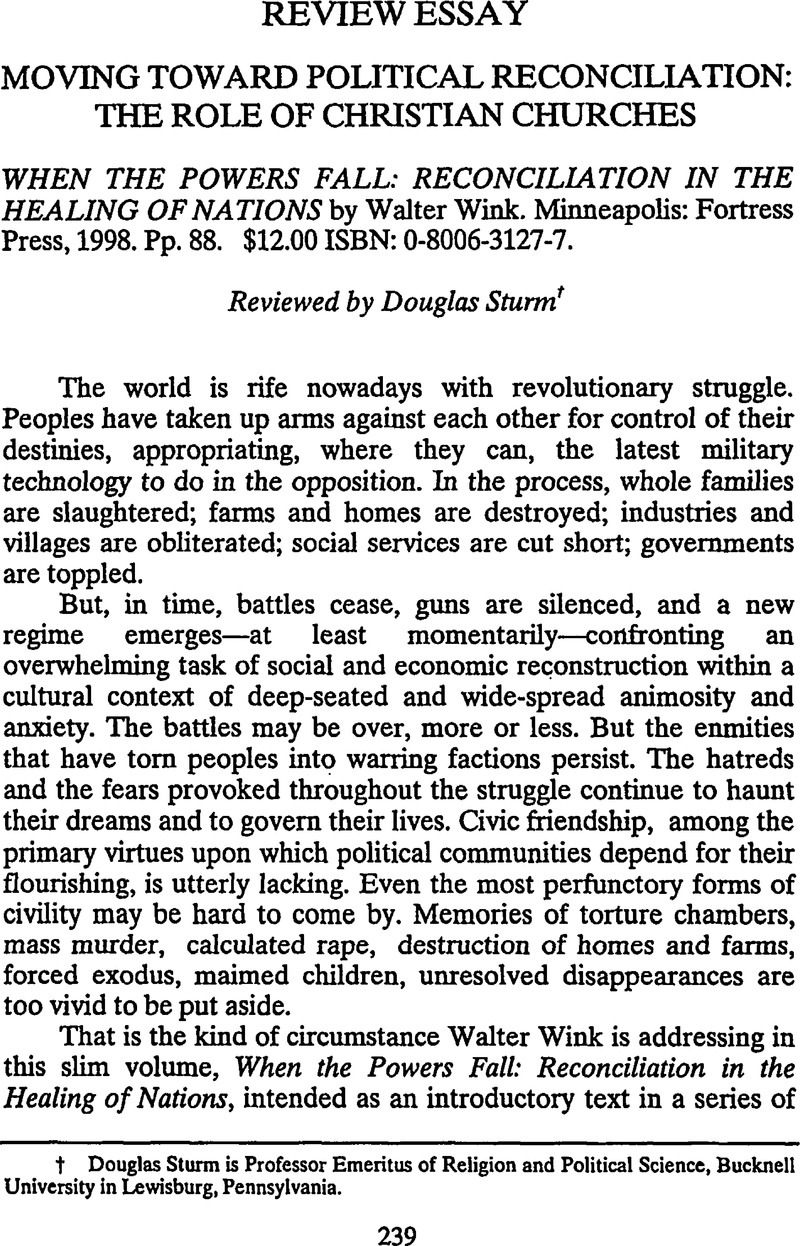Article contents
Moving Toward Political Reconciliation: The Role of Christian Churches
Published online by Cambridge University Press: 24 April 2015
Abstract

- Type
- Review Essay
- Information
- Copyright
- Copyright © Center for the Study of Law and Religion at Emory University 1996
References
1. All citations in the text refer to the book under review.
2. In this connection, Wink comments that “The last supper and the crucifixion display Jesus' nonviolent breaking of the spiral of violence by absorbing its momentum with his own body.” (p.10) Lest readers consider this appeal by Wink to nonviolence as a means of resisting evil as quaint but impracticable, we have, in recent years, multiple instances of the effective employment of nonviolence, often under exceedingly difficult circumstances. Apart from the well-known movements led by Mohandas Gandhi and Martin Luther King, Jr., consider the cases depicted in McManus, Philip and Schlabach, Gerald, eds., Relentless Persistence: Nonviolent Action in Latin America (New Society Publishers, 1991)Google Scholar.
3. Wink cites two cases in which churches issue formal apologies for wrongs done to native peoples. In one case the United Church of Canada apologized for prior actions by the church itself injurious to the native peoples of that land. In a second case, the United Church of Christ in the USA apologized to the natives of Hawaii for the illegal overthrow of the Hawaiian nation.
4. Assuming—as we should assume—that the Universal Declaration of Human Rights (1948) constituted an effort to articulate a standard of justice for all peoples and nations, drafted against the background of an intense struggle against forms of fascism, we can find many principles of justice there on which the positive law in nations throughout the world, including highly developed nations that have ratified the declaration, is silent, sometimes deliberately so. Take, for instance, article 25 which affirms that everyone has the right to a standard of living adequate for the health and well-being of self and family, including food, shelter, needed medical care and social services.
5. Consider, as cases in point, struggles against laws and decrees sanctioning the enslavement of peoples. The work of Bartolomé de las Casas in the 17th century opposing the enslavement of indigenous peoples of North America during the period of the Spanish conquest is described in detail in Wagner, Henry Raup, The Life and Writings of Bartolomé de las Casas (Albuquerque: U of NM Press, 1967)Google Scholar. John T. Noonan, Jr., depicts the ambiguity, if not the perversity, of the laws of slavery in early America, in chapter 2 (pp. 29-64) of his Persons and Masks of the Law (Farrar, Straus and Giroux, 1976)Google Scholar.
6. “Conservatism” nowadays is, of course, a term of multiple meanings. In this context, I am primarily concerned with the political policies of economic conservatives—those favoring the interests of corporate capitalism—which are often presented as the obvious implication of the “natural laws” of economic life.
- 1
- Cited by


